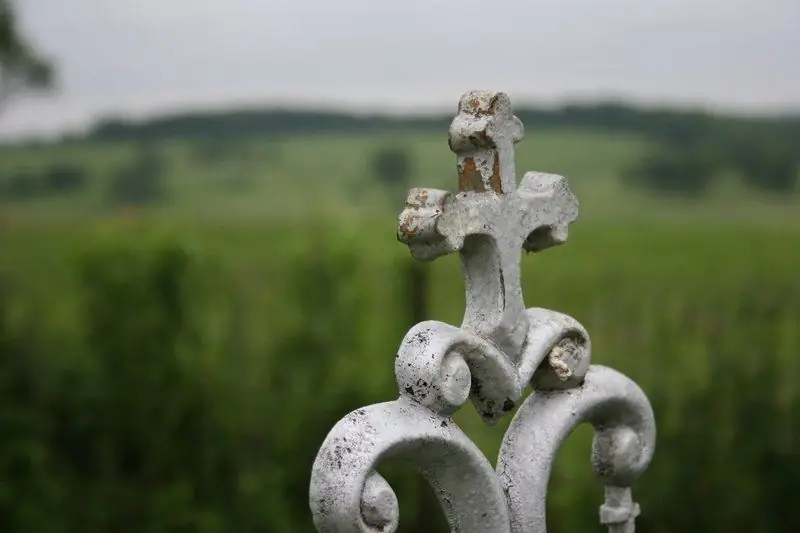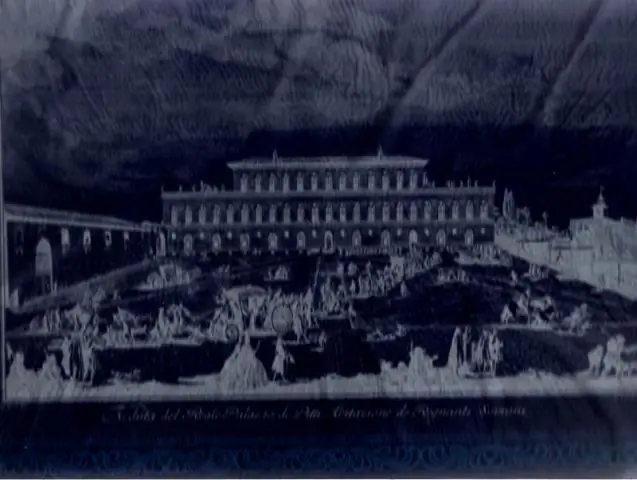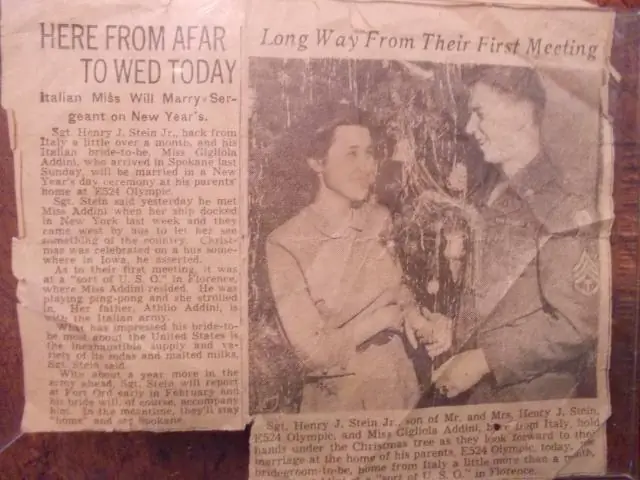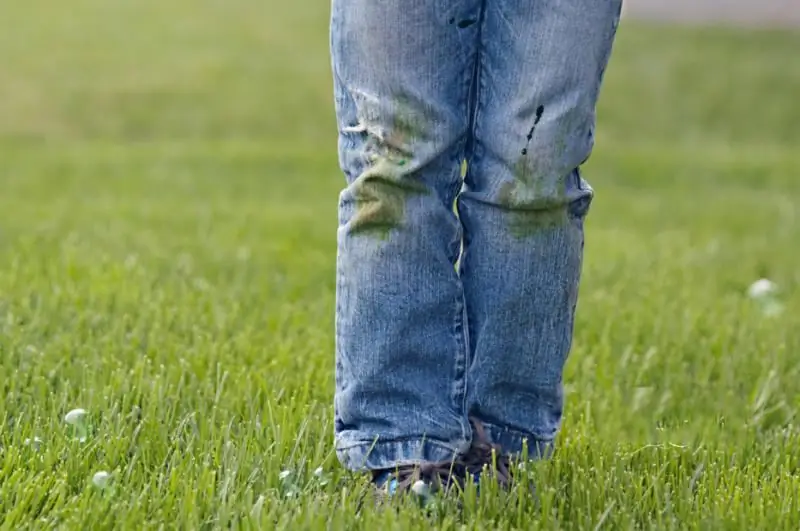
Table of contents:
- Author Bailey Albertson [email protected].
- Public 2023-12-17 12:53.
- Last modified 2025-01-23 12:41.
Cemetery site maintenance: how to get rid of weeds

Caring for graves in a cemetery is the duty of every Orthodox person who honors the memory of loved ones. Due to the fact that the cemetery soil is not subjected to any processing, weeds quickly grow on it. It is impossible to destroy it once and for all, but there are methods that will allow you to take a break from weeds on the graves for several years.
Content
- 1 Features of removing grass in a cemetery
-
2 Effective methods of getting rid of grass
-
2.1 Chemicals
- 2.1.1 Reviews of herbicides
- 2.1.2 How to use herbicides
- 2.1.3 Video: Treatment of a site in a cemetery with herbicides
-
2.2 Machining and mulching
- 2.2.1 Mulching with agricultural canvas or film
- 2.2.2 Mulching with gravel and sand
-
- 3 Traditional methods of weed control
Features of removing grass in a cemetery
Getting rid of unwanted plants in a cemetery is much easier than doing it in a garden plot. There is no problem to harm the soil or spoil its fertility, so you can use various chemicals or agents that make the land unsuitable for the growth of any plants.
The cultivated area in the cemetery is small, which simplifies the task. The only difficulties with which there may be difficulties are cultivated plants that are planted on the grave, forming a flower bed. In this case, weed control methods are severely limited. The simplest and most reliable means of preventing the appearance of weeds on the grave and the surrounding area is laying paving or street tiles on a substrate or a monolithic slab.
Effective methods for getting rid of grass
Grass growing in a cemetery has a developed root system that can penetrate deep enough into the substrate. To remove shoots, as well as prevent the appearance of weeds in the future, cardinal measures are needed. The desired result can be achieved as a result of chemical soil treatment, mechanical removal of plants during digging or mulching.
Chemicals
Systemic herbicides of continuous action are used to cultivate the land in the cemetery. The peculiarity of their work is the destruction of all vegetation on the territory. The chemical is sprayed all over the site, after about 2 weeks all the weeds dries up, after which its aerial part is removed mechanically. To maximize the effect, spraying poisons is carried out twice with an interval of two weeks.
Glyphosate-based preparations are ideal for cultivating the land in a cemetery. It is an active substance derived from phosphoric acid that allows you to fight annual and perennial dicotyledonous plants. The following tools can be used:
-
"Hurricane Forte" is a concentrated preparation designed to combat weeds such as wheatgrass, dandelions, squid, etc. It has a pronounced effect, penetrates deep into shoots and roots, slowing down metabolic processes, leads to the death of a plant, remains in the ground for a long time. 15 ml of concentrate is diluted in 1 liter of water, the resulting solution is sufficient to treat a site up to 25 sq. m.;

"Hurricane Forte" Hurricane Forte is a powerful systemic herbicide based on glyphosate
-
"Antiburian" - a drug in liquid form, produced in volumes of 0.1, 0.5 and 1 liter. It actively inhibits metabolic processes in 300 types of weeds, does not accumulate in the soil and acts quickly. Dilute 80 ml of concentrate in 5 liters of water and spray an area up to 100 sq. m.;

"Antiburian" Antiburian is a systemic herbicide designed to control most of the known weeds on all types of sites
-
Tornado is a popular broad spectrum herbicide suitable for controlling 150 plant species. 10 ml of the drug is poured with 3 liters of water. The resulting product is sufficient for processing 50-100 square meters of soil in order to destroy and prevent weeds. Substances penetrate the shoots, pass through the descending system of substances transport, affect the growth meristems in the plant, which leads to its complete death.

"Tornado" "Tornado" - an effective tool for weed control in agricultural and wasteland areas
Herbicide reviews
How to use herbicides
Herbicides are dangerous pesticides. They can cause serious poisoning in humans if they enter the body, on the skin or mucous membranes. There are safety rules for working with chemicals. It is necessary to spray them under the following conditions:
- when there are no people or animals nearby;
- in calm dry weather;
- at an air temperature of 12 to 25 degrees;
- during the flowering period of weeds;
- using specialized nebulizers and atomizers.
When spraying herbicides, it is forbidden to drink, eat, smoke, remove personal protective equipment, wipe sweat and eyes. The following protective equipment must be used:
- respirator;
- latex gloves;
- a chemical protection suit with a hood that covers the entire length of the arms, legs and head;
- protective goggles that fit tightly to the face, it is better if it is a respirator mask.
Video: processing a site in a cemetery with herbicides
Mechanical processing and mulching
A cemetery is an open, large area where there is no way to control the growth and spread of weeds. Therefore, the methods that are used to maintain the land in vegetable gardens and home gardens are very different from those suitable for cemeteries. A simple digging of the soil with the removal of the root system of weeds will not be enough, since plant seeds from neighboring plots will easily fall into an already well-groomed area and the process of soil contamination will begin anew. Soil mulching involves creating a barrier that keeps the sun out of the soil. After a while, all the plants on the site will die, since daylight is needed for their life.
Mulching with agricultural cloth or film
Both agricultural canvas and film are sold in rolls - these are opaque materials that cover the earth to protect it from the sun. This method has some disadvantages when used on a graveyard site:
- a positive result will be achieved in a few years, since the plants do not die immediately;
- the grass on the site will not grow until you remove the film;
- water and earth will accumulate on top of the film, which is carried by the wind, after which new weeds will begin to grow on top of the agricultural canvas.

An agricultural canvas spread on the ground does not allow sunlight to penetrate the plants, as a result of which they die
The advantage of this approach is that it allows you to preserve beautiful flower beds on which you can plant cultivated plants. To carry out the procedure, you can use the following recommendations:
- We carry out mowing of weeds on the site.
- We dig up the ground where the weeds grow, carefully choosing their roots.
- We level the ground so that there are no drops and the film lies flat.
- We cover the ground with an opaque cloth, pressing it along the edges with stones or other weight.
Mulching with rubble and sand
The essence of mulching with building mixtures is that the ground is completely covered with them, as a result of which the plants do not receive the light that is so necessary for growth. The most common mulching materials are:
- gravel of different fractions;
- sand;
- crushed stone;
- ash.

Mulching a site in a cemetery with rubble allows you to create conditions unfavorable for the development of plants
The mulching procedure can be carried out as follows:
- We cut all the weeds on the site.
- Using a pitchfork or a shovel, we dig up the ground and remove the top layer of soil to a depth of 20 centimeters.
- We fill up with sand or other material.
- We align and ram the area well.
Traditional methods of weed control
Long before industrial plant poisons were invented, people used folk remedies. Today, they do not differ in high efficiency compared to the purchased formulations, but at the same time they continue to be actively used in areas not intended for sowing with crops. The most popular are the following tools:
-
salt - this substance not only destroys plants, but also makes the soil unsuitable for the germination of any organisms for a long time, it is used in the form of a solution and in its pure form:
- the solution is prepared from 250 g of salt and 1 liter of water, and then poured into a spray bottle and sprayed over the area;
-
the area is covered with pure salt at the rate of 1.5 kg per 1 sq. m. area - after the procedure, the land becomes unsuitable for all living things;

Salt in the spoon and on the table Table salt helps to combat weeds in the cemetery
- vinegar - mix water with vinegar in equal proportions in a volume of 400 ml, add 100 ml of medical alcohol, a bag of citric acid and several tablespoons of dishwashing detergent to the composition, and the resulting composition is poured into a container with a spray, after which the site is treated.
Read about the rules and prohibitions when visiting the cemetery in our new article -
Caring for graves involves removing weeds that grow in the burial area. It is easier to control vegetation in a cemetery than in any other area, since there is no need to preserve the nutritional properties of the soil. For this, herbicides, mulching method or some folk remedies are used.
Recommended:
How To Get Rid Of Spiders In A Private House, Apartment, Balcony, Windows And Other Places Forever, Tips With Photos And Videos

How to get rid of spiders in a house or apartment. Should you be afraid of them? How to remove spiders: effective chemicals and folk remedies
How To Get Rid Of Rats In A Private House, Chicken Coop, Apartment And Other Premises - Using Various Methods To Get Rid Of Rodents

Reasons for the appearance of rats in the house. What methods, means to use in the fight against rats in various residential and non-residential premises. Preventive actions. Video
How And How To Get Grass Off Your Jeans: Different Ways To Quickly Get Rid Of Stains At Home

How to quickly get rid of grass stains on jeans? Machine washable rules, as well as 9 effective life hacks to remove fresh and old traces of grass
How To Easily Get Rid Of Weeds And Grass Forever With Folk Remedies

How to get rid of weeds using folk methods. Can vinegar, salt and other aggressive substances be used against a herb to remove it forever?
5 Things I Will Get Rid Of Before The New Year To Bring Happiness And Wealth Into The House, As Well As Get Rid Of Negativity

According to the old tradition, before the New Year, I get rid of 5 unnecessary things in order to let the positive energy of happiness and prosperity into my life
